Choosing the right surgical display involves many technical details. One key difference is how the screen is constructed. This choice affects image quality, durability, and even hygiene in the demanding operating room environment.
Fully laminated glass surgical displays are generally better than traditional panels. They offer superior image clarity, reduced glare, enhanced durability, and easier disinfection, making them more suitable for critical surgical applications.

The technology behind a surgical monitor1‘s screen can significantly impact its performance in the operating room. Traditional panels and fully laminated displays2 represent two distinct approaches to screen construction3. Understanding these differences is important for making an informed decision. This article will explore these structural variations, their effects on visual performance, cleanability, durability, and how we incorporate advanced lamination in our designs.
What is the structural difference between traditional panels and laminated glass displays?
The way a display’s layers are assembled might seem minor. However, it fundamentally changes how light interacts within the screen. This difference can impact what the surgeon ultimately sees.
Traditional panels typically have a noticeable air gap between the LCD module and the protective outer cover glass. Fully laminated displays bond these layers directly together, eliminating the air gap for a more integrated structure.
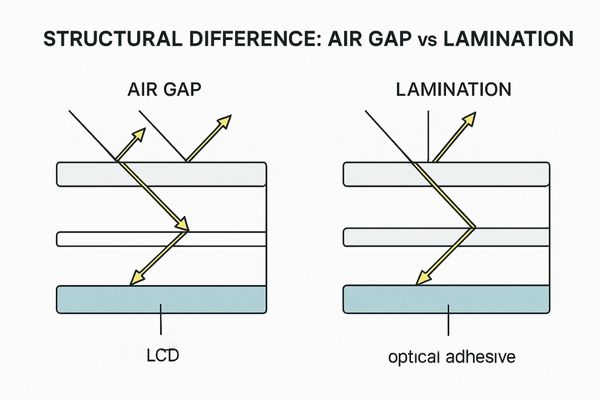
The primary structural distinction lies in the space, or lack thereof, between the actual liquid crystal display (LCD) panel and the protective outer glass or transparent layer.
Traditional Panel Structure4
In a traditional construction, the LCD panel sits behind a separate piece of cover glass. An air gap exists between these two layers. This air gap can be a source of internal reflections. Light from the LCD passes through the air gap before reaching the cover glass, and external light passes through the cover glass and the air gap before reaching the LCD. Each interface between materials (LCD to air, air to glass) can cause light to refract and reflect.
Fully Laminated Display Structure5
In a fully laminated display, an optically clear adhesive6 is used to bond the LCD panel directly to the inner surface of the protective cover glass. This process eliminates the air gap. The result is a single, solid optical unit. This direct bonding changes how light travels through the display, generally leading to improved optical characteristics. This integrated structure not only affects visual performance but also contributes to the display’s overall robustness and profile.
How does lamination affect image clarity and glare reduction?
A surgeon needs the clearest possible view. Glare from OR lights or reflections within the screen can obscure vital details. We will see how lamination addresses these visual challenges.
Full lamination significantly reduces internal light refraction and reflections. This results in improved perceived contrast, truer color fidelity, and less glare, which is critical for clear viewing under intense surgical lighting.
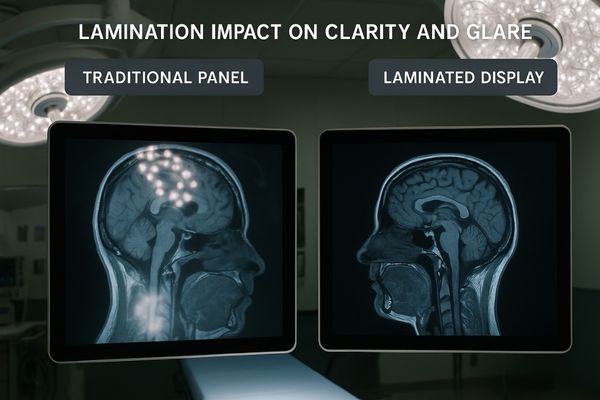
The elimination of the air gap in fully laminated displays has a profound impact on image clarity7 and glare.
Reduced Internal Reflections
In traditional panels, the air gap creates two additional surfaces where light can reflect internally: the top surface of the LCD and the bottom surface of the cover glass. These internal reflections can cause a slight "ghosting" effect or reduce the perceived sharpness and contrast of the image. By bonding the LCD directly to the cover glass, lamination minimizes these internal reflection points. The light from the LCD passes more directly to the viewer’s eyes.
Enhanced Contrast and Color8
With fewer internal reflections scattering light, the dark areas of an image appear darker, and colors appear more saturated and true to life. This improved contrast ratio makes it easier to distinguish subtle variations in tissue and anatomical structures. The visual experience is often described as the image being "closer" to the surface of the screen.
Glare Reduction9
External light sources, like bright OR lights, can cause significant glare on a monitor screen. While anti-reflective (AR) coatings on the outer surface help, the air gap in traditional panels can still trap some reflected light, reducing visibility. Laminated displays, by minimizing internal reflective surfaces, often perform better in high-ambient-light conditions. The image appears clearer and less washed out, even under direct lighting. This is crucial for maintaining focus during long and complex surgical procedures.
Are laminated surgical displays easier to clean and disinfect?
Infection control is paramount in operating rooms. Equipment must be easily and thoroughly disinfected. The physical design of a monitor can help or hinder this critical process.
Yes, fully laminated surgical displays are generally easier to clean and disinfect. Their seamless, flat glass surfaces eliminate crevices found in air-gap designs, facilitating more thorough cleaning and supporting better infection control protocols.
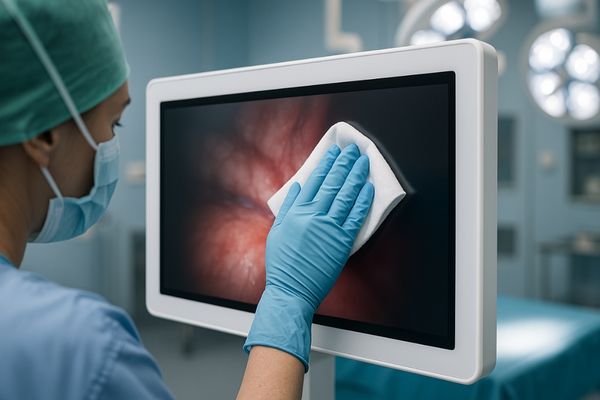
The cleanability of medical equipment10 is a non-negotiable aspect of operating room hygiene11. The construction of the display plays a role here.
Challenges with Traditional Panels
Traditional panels with an air gap often have a bezel or frame that holds the cover glass in place over the LCD. This design can create small crevices and edges around the perimeter of the screen where the cover glass meets the casing. These areas can trap dust, fluids, and microorganisms, making them difficult to clean thoroughly. Even if the front surface is wiped, contaminants can remain in these hard-to-reach spots.
Advantages of Laminated Displays
Fully laminated displays typically present a completely flat, seamless front surface. Because the cover glass is bonded directly to the LCD and often extends edge-to-edge, or is sealed into the housing, there are fewer or no crevices for contaminants to accumulate. This smooth, unbroken surface allows for easier and more effective wiping with hospital-grade disinfectants. The absence of an air gap also means there is no internal space where condensation or contaminants could potentially ingress and become trapped if the outer seal were ever compromised. This makes laminated displays12 inherently better suited for environments where stringent infection control is a priority. The ease of cleaning contributes to a safer surgical environment.
What are the durability and impact resistance differences?
Operating rooms are busy environments. Equipment can be subject to accidental bumps or contact. A display’s ability to withstand such an environment is important for its longevity.
Laminated displays generally offer greater structural durability and impact resistance. The bonded layers create a more robust unit, making them less susceptible to damage from physical shocks or wear compared to traditional air-gap panels.
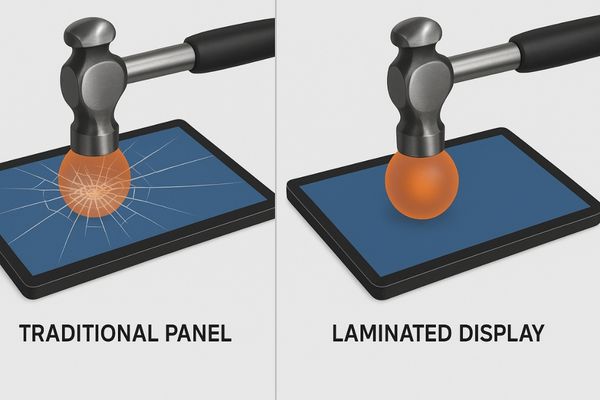
The physical robustness of a surgical display is crucial for its longevity in a demanding OR setting.
Durability of Laminated Displays
In a fully laminated display, the bonding of the cover glass directly to the LCD panel creates a more rigid and unified structure. This composite structure can distribute the force of an impact more effectively than a traditional panel where the cover glass and LCD are separate components. The adhesive layer itself can also provide some shock absorption. This makes laminated screens generally more resistant to damage from accidental bumps, pressure, or even minor drops. The overall construction feels more solid.
Durability of Traditional Panels
With traditional panels13, the cover glass is often held in place by a bezel. An impact to the cover glass could potentially cause it to flex and hit the underlying LCD, or even dislodge, if the impact is significant. The air gap itself offers no structural support. While the cover glass provides protection, the overall assembly might be less resilient to certain types of physical stress.
Furthermore, the lack of an air gap in laminated displays14 reduces the possibility of dust or moisture ingress between the layers over time, which can degrade image quality or cause component failure in traditional panels if seals are not perfect. The enhanced structural integrity of laminated displays contributes to a longer operational life, especially in environments where equipment may be frequently moved or adjusted.
| Feature | Traditional Panel (Air Gap) | Fully Laminated Display |
|---|---|---|
| Internal Reflection | Higher, due to air gap interfaces | Minimal, direct optical path |
| Perceived Contrast | Potentially lower | Higher, deeper blacks |
| Color Fidelity | Can be affected by reflections | More accurate and vibrant |
| Glare (Internal) | More prone | Reduced |
| Cleaning | Crevices can trap contaminants | Seamless, easier to disinfect thoroughly |
| Impact Resistance | Cover glass can flex into air gap | More rigid, bonded structure |
| Dust/Moisture Entry | Possible into air gap over time | Sealed, no internal air gap |
This table summarizes key differences discussed.
How does Reshin apply lamination technology in its surgical monitor design?
Understanding the benefits of lamination is one thing. Implementing it effectively requires careful engineering. We integrate this technology to maximize its advantages for surgical applications.
We apply full lamination technology in our MS-series surgical monitors. This is often combined with anti-reflective (AR) coatings and IP-rated ingress protection to deliver superior image quality, enhanced hygiene performance, and extended product longevity for demanding ORs.
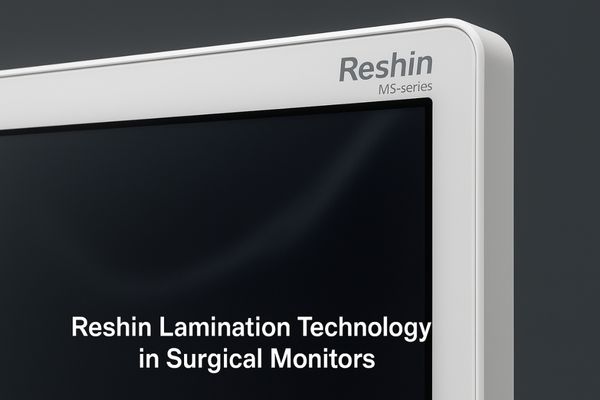
We recognize the significant advantages that full lamination15 brings to surgical environments. Therefore, this technology is a core feature in many of our advanced surgical displays, particularly within our MS-series. Our implementation involves bonding a protective, often chemically strengthened, glass directly to the high-resolution LCD panel using an optically clear adhesive. This meticulous process eliminates the air gap, leading to the direct benefits of improved optical clarity, reduced glare, and enhanced contrast, which surgeons need for precise visualization.
Beyond just the lamination, we often couple this with other protective and performance-enhancing features. For instance, the outer surface of the laminated glass is frequently treated with an anti-reflective (AR) coating16 to further minimize glare from bright OR lights. Many of our surgical monitors, like the MS321PB, also feature high Ingress Protection (IP) ratings17, such as IP65 for the front panel. This means the front surface is sealed against dust and water jets, making it highly suitable for cleaning and disinfection protocols common in operating rooms. The combination of full lamination, AR coatings, and robust, sealed designs ensures our monitors not only provide excellent image quality but also stand up to the rigorous demands of daily surgical use, promoting both patient safety and long-term reliability.
Conclusion
Fully laminated glass displays offer superior clarity, reduced glare, easier cleaning, and better durability than traditional panels. These features make them the preferred choice for demanding surgical environments. To equip your OR with high-performance laminated glass monitors, contact Reshin at martin@reshinmonitors.com.
-
Explore this link to understand the essential features and benefits of surgical monitors in the operating room. ↩
-
Discover the benefits of fully laminated displays and how they enhance medical technology performance. ↩
-
Learn about the impact of screen construction on monitor performance, crucial for surgical environments. ↩
-
Understanding traditional panel structures can help you appreciate the evolution of display technology and its impact on visual quality. ↩
-
Explore the advantages of fully laminated displays, including improved optical performance and durability, to enhance your understanding of modern display technology. ↩
-
Learn about optically clear adhesives and their crucial role in enhancing display quality and performance in modern technology. ↩
-
Exploring this resource will help you understand how image clarity enhances visual experiences and its importance in various applications. ↩
-
This link will provide insights into how enhanced contrast and color can significantly elevate the viewing experience, especially in critical fields. ↩
-
Discovering glare reduction techniques can help you choose the right display technology for environments with challenging lighting conditions. ↩
-
Understanding the cleanability of medical equipment is crucial for maintaining hygiene in operating rooms, ensuring patient safety and infection control. ↩
-
Discovering modern technologies that improve operating room hygiene can lead to better patient outcomes and safer surgical practices. ↩
-
Exploring the benefits of laminated displays can reveal how they enhance hygiene and safety in medical settings, crucial for infection control. ↩
-
Learn about the limitations of traditional panels and why they may not be suitable for high-stress environments like operating rooms. ↩
-
Explore how laminated displays enhance durability and performance in demanding surgical settings, ensuring longevity and reliability. ↩
-
Explore how full lamination enhances optical clarity and reduces glare, crucial for surgical precision. ↩
-
Learn how AR coatings minimize glare from bright lights, improving visibility in operating rooms. ↩
-
Understand the importance of IP ratings in ensuring monitors are safe and easy to clean in surgical environments. ↩

